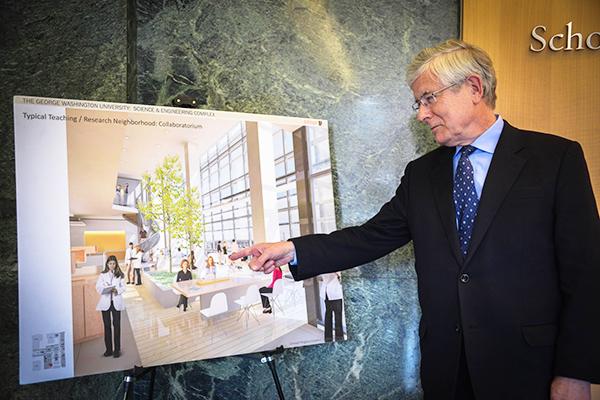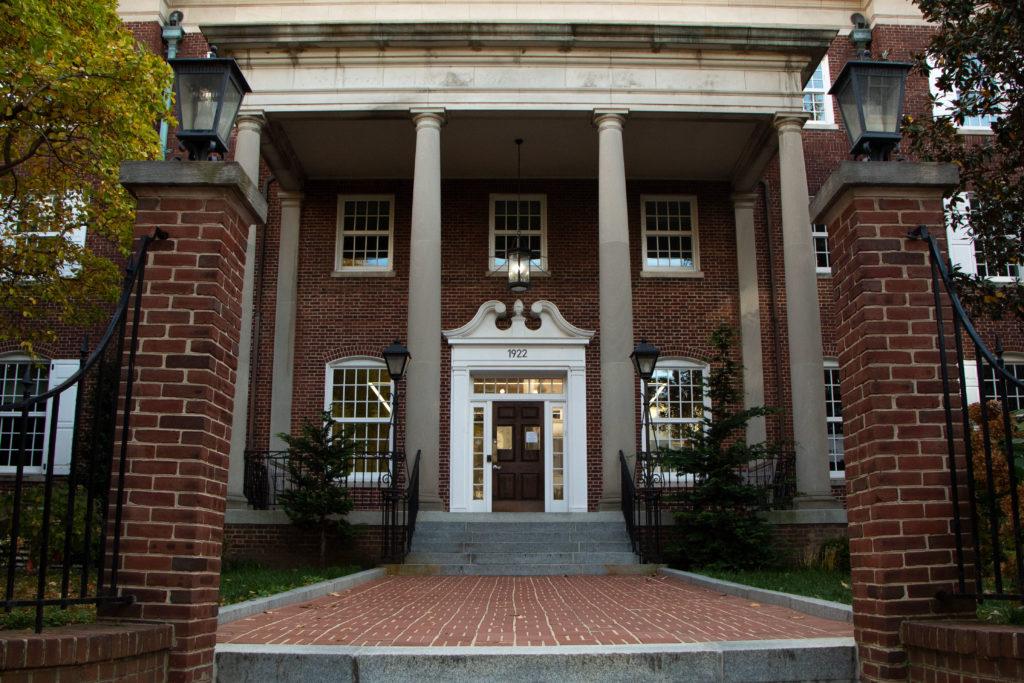This is the third in a series of profiles on GW’s 10 deans.
When David Dolling moved into the dean’s office in Tompkins Hall in 2008, he had to become one of the chief advocates for GW’s most expensive construction project ever, the $275 million Science and Engineering Hall.
In one of his first years as leader of the engineering school, Dolling came to a Faculty Senate vote on the future of the controversial project with professors behind him to help fill the room with supporters, faculty recall.
While Dolling said he heard out the critics, he knew he would prove to his colleagues “that the decision that was made was a right one.”
“When people think GW, they think policy, international affairs. In a few years when people think GW, I want them to think international affairs, comma, engineering. So that’s our goal, and I think it’s doable,” Dolling said.
Dolling had earned the deanship – his first – with a vision about how to grow the School of Engineering and Applied Science into its massive new building, which reaches eight floors high and stretches a block wide.
Dolling took the helm of the University’s 130-year old engineering school during the first time in recent GW history that the program wasn’t an afterthought. With the building springing up as an attraction for new hires and donors, he’s brought in nearly 50 professors, quadrupled fundraising and more than doubled the school’s endowment to $21 million. The school’s endowment is now the fifth-smallest among GW’s 10 colleges, up from the third-smallest last year.
“It doesn’t matter if you walk up 23rd Street or 21st Street. You see it. It’s right there. It’s a visible symbol. And we’ve been, as an engineering school, trying to prepare ourselves to be worthy of this fabulous building,” Dolling, 63, said.

In his five years as dean, he’s had to make tough calls like divvying up office space and settling department politics. He’s also dealt with a school that’s faced flagging enrollment and drop-offs in rankings. His biggest challenge has been to justify a cost that’s been questioned by faculty leaders who believed it was too expensive for a politics-focused institution – but he thinks that will change.
The $275 million building, a sign of a magnitude envied across colleges, has come up short on fundraising to cover the cost of construction. With the slow pace of donations, GW has lowered its fundraising expectations from $100 million to less than $75 million, with the rest coming from debt payments and federal research subsidies. The pressure will mount over the next year as GW strives to pull in donations before the building opens and the chances for donations drops.
Although the school has caught the eye of mega donors like Siemens, IBM, Rolls Royce and Ford Motor Company, the school remains far behind the country’s elite engineering programs in prestige, fundraising and endowment.
It was ranked No. 90 for best undergraduate engineering programs in the country by U.S. News & World Report this year, falling five slots from the previous year.
Dolling’s legacy will likely be the fleet of tenured faculty focused on upping the school’s research profile, Provost Steven Lerman said. Last year alone, research spending grew more than 40 percent.
“He’s attracted this next generation of young faculty – an extraordinary cohort of talented people from top-tier institutions,” Lerman said in an interview. “Of his many accomplishments, that one will have the longest enduring impact because those are the people who will become the school’s foundation.”
By the time the Science and Engineering Hall opens, about half of the school’s tenured faculty will have spent less than five years at GW. With still a year until the building opens, some of the newly hired professors have had to improvise, turning basement space in the Elliott School of International Affairs into a robotics lab because they couldn’t find enough space in Tompkins Hall.
Board of Trustees chair Nelson Carbonell said Dolling has lured top-tier research faculty with the promise of the building’s opening.
“It’s one of the big assets he had to sell. He’s used that really effectively to recruit people,” Carbonell said. “Just the fact that we’re building it has helped us hire people who would have never come here – and it’s not even done yet.”
Dolling is a mild-mannered British transplant who has lived in the U.S. for most of his adult life. He grew up in a quiet town on the south coast of England, where most of his neighbors were retired, and then enrolled at the University of London to study aerospace engineering.
After working several years in England, he moved to Belgium and earned a graduate degree at an internationally renowned fluid dynamics institute, which he said changed his life. He said that experience is the reason he pushes GW engineers to study abroad, unlike many top institutions with tepid approaches to overseas study within their rigorous programs.
Before coming to GW, he also spent 25 years at the University of Texas at Austin, where he served as an associate dean for academic affairs and the aerospace engineering department chair.
Charles Garris, a professor of mechanical and aerospace engineering who has spent nearly 30 years at GW, said Dolling has inspired even the older faculty to embrace the school’s new vision.
“His goals are aggressive yet reasonable, and he has been very effective in gaining the confidence and support of the faculty and engendering a sense of teamwork within the school,” said Garris, who is also one of the longest-serving members of the Faculty Senate.
In line with his love of airplanes, Dolling said he always gives prospective faculty and students this advice:
“When you join any organization, the organization itself can either be doing three things: It can be going down, it can be going horizontal or it can be going up,” he said. “And there is only one place of those three that you want to be, and that’s the one that’s going up.”








